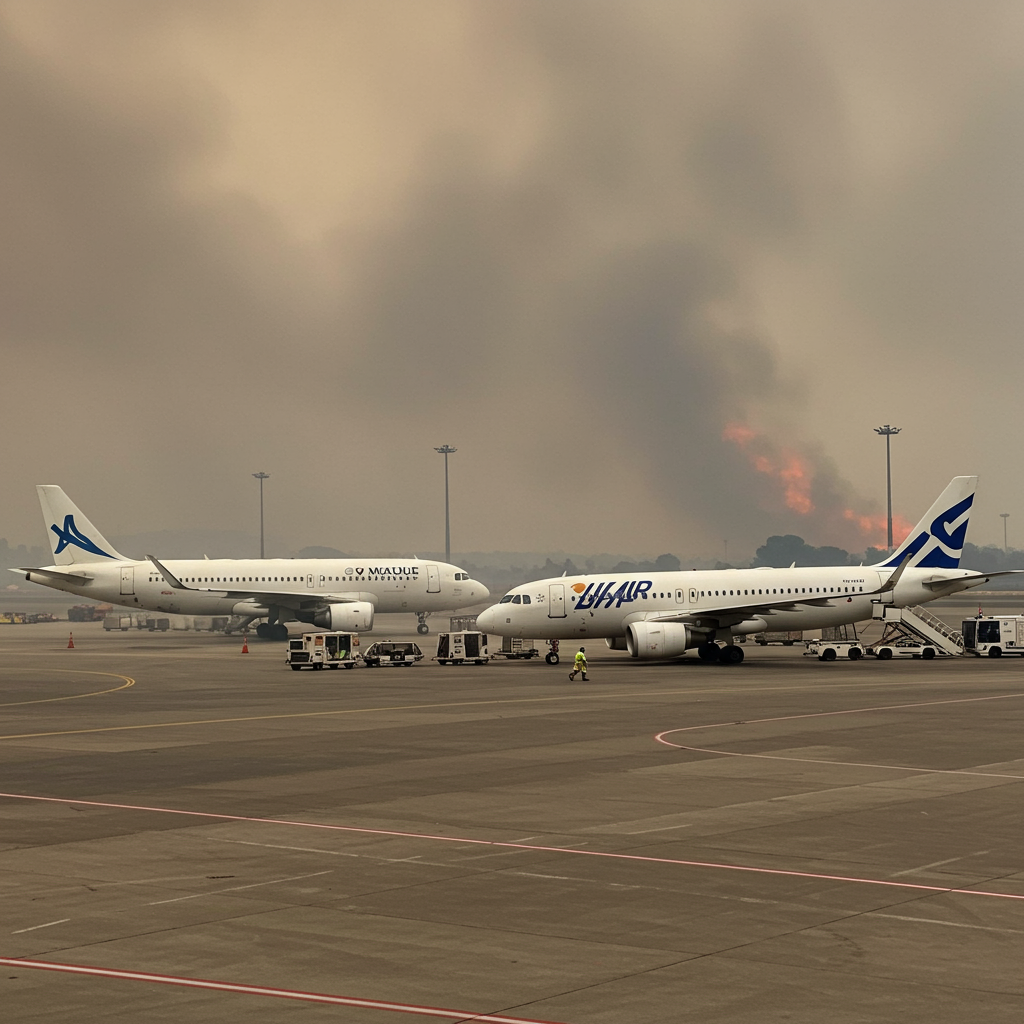marseille Airport Flights Halted Amid Fierce Wildfire Battle Near French City
A major wildfire erupted near Marseille, France’s second-largest city, leading to significant disruption including the closure of Marseille Provence Airport to commercial traffic. Flames spread rapidly towards the city’s northwestern outskirts, fueled by intense winds. while emergency crews continue a relentless battle, the blaze has forced evacuations, damaged homes, and cast a pall of thick smoke over the region. The incident marks an early and severe start to the summer wildfire season in southern France, drawing comparisons to recent blazes across the Mediterranean.
Wildfire Explodes Near Marseille
The intense wildfire began near a motorway on the outskirts of Marseille. Officials stated the fire’s cause was a car that caught ablaze. Propelled by powerful Mistral winds, gusting up to 70 kilometers per hour (43 mph), the fire tore through dry vegetation. This rapid spread brought the flames alarmingly close to populated areas, including the 16th arrondissement of Marseille. Eyewitnesses described the scene as “apocalyptic,” with massive smoke plumes reducing visibility and severely impacting air quality. One report noted certain particle concentrations were ten times higher than regulatory limits.
The speed and scale of the fire overwhelmed initial efforts. By late Tuesday, the blaze had already consumed an estimated 700 hectares, equivalent to roughly 2.7 square miles. Authorities described the fire as fast-moving and particularly challenging to contain due to the weather conditions.
Impacts on Infrastructure and Residents
The immediate danger posed by the fire led to significant disruptions. Marseille Provence Airport temporarily suspended commercial flights to allow firefighting aircraft and helicopters priority access to the airspace. While a partial resumption occurred later, the potential for further closure remained if conditions worsened. Nearby train services were also suspended as a precaution.
Hundreds of residents in affected zones were instructed to stay indoors for safety as the fire approached. In the 16th arrondissement, a temporary lockdown was imposed. While this specific lockdown was lifted by Wednesday morning as the situation eased in that sector, the overall impact on communities was profound. Hundreds of people were forced to flee their homes, seeking shelter away from the advancing flames.
Structural Damage and Casualties
The wildfire caused direct damage to property. Interior Minister Bruno Retailleau confirmed that 60 houses were affected, with 10 of them completely destroyed by the fire. Firefighters worked tirelessly through the night to save hundreds of other homes, demonstrating remarkable bravery in the face of extreme conditions.
Fortunately, despite the scale and intensity of the blaze, no fatalities have been reported so far. However, the human cost includes injuries. Officials stated that 110 people suffered minor injuries related to the fires. Separately, nine firefighters sustained slight injuries while battling the blaze.
Massive Emergency Response Mobilized
Hundreds of firefighters were immediately deployed to the scene. These ground crews received crucial support from helicopters and firefighting aircraft. The use of these aerial resources was a key factor necessitating the airport’s closure to ensure safe and efficient operations.
Marseille Mayor Benoit Payan provided updates on the situation, announcing the lifting of the lockdown in the 16th arrondissement but urging continued caution due to emergency personnel activity. Regional Prefect Georges-Francois Leclerc and Interior Minister Bruno Retailleau also commented on the scale and challenges faced by responders. The head of the local council, Martine Vassal, acknowledged the overnight efforts but stressed that the fight was far from over, citing ongoing “worrying weather conditions.”
Officials Monitor and Support Efforts
High-level government officials are closely monitoring the situation. Interior Minister Bruno Retailleau visited the area to show solidarity with the firefighters and affected residents. French President Emmanuel Macron also sent a message of support, acknowledging the difficult work being done and the plight of those impacted.
Government spokesperson Sophie Primas highlighted the significance of the Marseille fire. Along with a separate blaze near Narbonne, this incident marks the first major wildfire of the summer season in southern France. Primas noted that the season has arrived earlier this year, raising concerns for the months ahead.
The Human Impact and Lingering Concerns
For residents caught in the path of the fire, the experience has been devastating. One evacuee, identified only as Philippe, shared his distress with a broadcaster, describing the situation as “very very, very hard.” Having slept poorly after being forced to leave his home, he expressed hope of returning soon, but the uncertainty remained palpable.
Another resident, Yanis from the Estaque district, felt the danger was “not over” despite reports of the fire being “under control” in some areas. He observed “many houses are still on fire” and “a lot of flames everywhere,” reflecting the complex and ongoing nature of the incident. While the intensity decreased overnight, officials emphasized that the situation was “not yet fixed” and that the upcoming nights would be “critical” for containment efforts.
Wildfires in a Changing Climate
The severe wildfire near Marseille is being viewed within a broader context of increasing fire activity in the Mediterranean region. Experts and officials, including spokesperson Sophie Primas, link the rising frequency and destructiveness of these events to climate change.
Recent weeks have seen significant wildfires also rage in other Mediterranean countries. Incidents in northeastern Spain, on the Greek island of Crete, and near Athens underscore a pattern of heightened wildfire risk across the region. Conditions like prolonged heat, dry landscapes, and strong winds, exacerbated by a changing climate, create a volatile environment where fires can start easily and spread with terrifying speed. While winds near Marseille were forecast to weaken slightly, temperatures remain high, and the dryness means the fire risk persists, even with less wind expected until Friday.
Frequently Asked Questions
What is the current status of the Marseille wildfire?
As of Wednesday, July 9, 2025, the intensity of the wildfire near Marseille has decreased compared to the previous day. However, firefighters are still actively battling the blaze, particularly in some northern sectors. Officials caution that the situation is “not finished” and remains challenging due to weather conditions, although one area (the 16th arrondissement) saw its lockdown lifted as the fire was “clearly under control” there. Hundreds of firefighters and aerial resources remain deployed.
Is Marseille Airport still closed due to the fire?
Marseille Provence Airport temporarily suspended commercial flights to prioritize aerial firefighting efforts. While there was a partial resumption reported, officials indicated the airport could potentially close again for commercial traffic if the situation worsens to allow more resources for water-bombing aircraft and helicopters. Travelers should check directly with the airport and airlines for the latest flight status updates.
How much land has been burned and what is the damage?
The wildfire near Marseille has burned an estimated 700 hectares (approximately 2.7 square miles) as of late Tuesday. The fast-moving fire affected 60 houses, with 10 homes completely burned down. Hundreds more homes were successfully saved by emergency crews. Fortunately, no fatalities have been reported, though 110 people, including nine firefighters, suffered minor injuries.
The battle against the Marseille wildfire continues, a stark reminder of the escalating challenges posed by extreme weather and dry conditions in the Mediterranean. While initial intensity has lessened, the combination of high temperatures and persistent winds means the risk remains high. Emergency services are maintaining their presence and efforts, and residents who evacuated are still awaiting permission to safely return home. The focus remains on full containment and supporting the communities impacted by this early-season blaze.



